|
|
|
|
Hirudocidaris hirudo (sorignet, 1850) |
One of the most common chalk cidaroids, and present throughout virtually all of the Chalk Group. Hirudocidaris hirudo is a relatively small cidaroid, with relatively short primary spines. Spine form is variable, but the ornament typically consists of a series of parallel longitudinal ridges. Some spine-forms resemble those of the related Hirudocidaris uniformis essensis, but that species has more strongly developed ribs.
|
|
|
1). (A) A spectacular specimen with a partially articulated compliment of primary spines and other body parts (x1.5, mould in flint, White Chalk, HCCMS (Hampshire County Council Museum's Service) collection, stored at Gosport Museum, G.1981.85, by kind permission of Dave Kemp, HCCMS). (B) A common form of primary spine; narrower and with straighter ridges than those in (A) (x3, Seven Sisters, Seaford Chalk Formation, Randell Collection, RR1806).
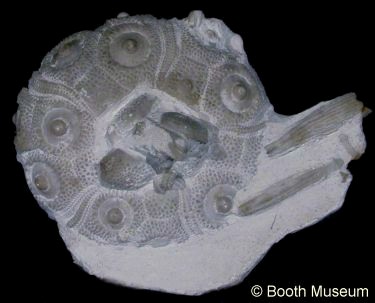 A
A |
 B B |
2). Complete test with spines; (A) Adapical view, genital plates and lantern elements are protruding from the apical opening, (B) Adoral view (both x2.0, 'Southerham', Lewes, Sussex, Willet Collection, Booth Museum, BMB 007897, by kind permission of John Cooper).
 A A |
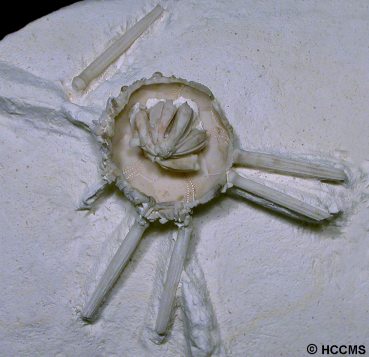 B
B |
3). (A) Lateral (side) view of a well preserved individual, displaying a further form of primary spine (x1.7, Alfriston, Sussex, Grey Chalk, Willet Collection, Booth Museum, BMB 007898, by kind permission of John Cooper). (B) A very well preserved individual, broken open exposing a near perfect Aristotle's Lantern (x2.0, White Chalk, HCCMS (Hampshire County Council Museum's Service) collection, stored at Gosport Museum, G.1981.205, by kind permission of Dave Kemp, HCCMS).
|
|
|
4). Views of the Aristotle's Lantern from the above specimen; (A) Adoral view; (B) Lateral view (x4.0).
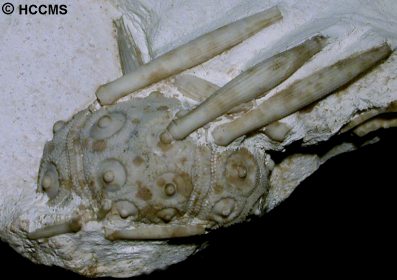 A A |
 B B |
5). Complete tests with spines; (A) (x2.0, White Chalk, HCCMS (Hampshire County Council Museum's Service) collection, stored at Gosport Museum, G.1983.403, by kind permission of Dave Kemp, HCCMS); (B) (x2, Alfriston, Sussex, Grey Chalk, Willet Collection, Booth Museum, BMB 007898, by kind permission of John Cooper).
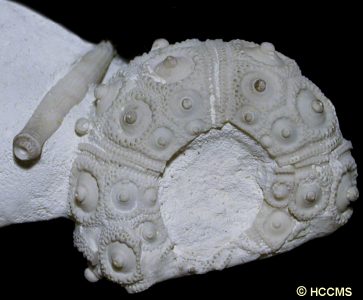 A A |
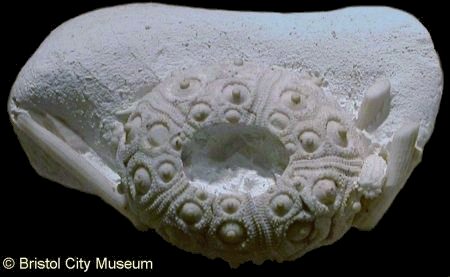 B B |
6). Adoral views of a complete tests with spines; (A) (x2.8, White Chalk, HCCMS (Hampshire County Council Museum's Service) collection, stored at Gosport Museum, G.1983.446, by kind permission of Dave Kemp, HCCMS); (B) (x1.5, White Chalk, in the collection of Bristol City Museum and Art Gallery).
 A A |
|
7). Disarticulated individuals; (A) An individual which has collapsed about its central axis (x2, Peacehaven, Newhaven Chalk Formation, Randell Collection, RR1234; (B) Dispersed test segments and primary spines (x1.3, Seven Sisters, Seaford Chalk Formation, Randell Collection, RR1806)
 A
A |
 B
B |
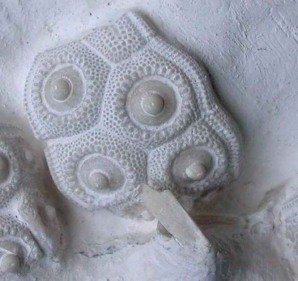 C
C |
8). Details of the above specimens; (A) Primary spines and the reverse side of a genital plate, the genital pore is very clear (x4); (B) A partial primary spine and a genital plate (x5); (C) Test segment and Lantern elements (x4).
 A A |
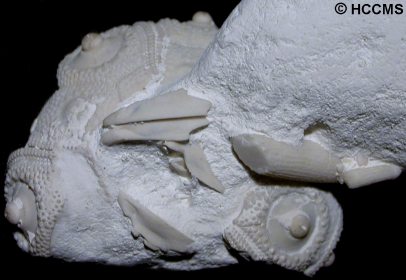 B B |
9). (A) Primary spine with a hemi-pyramid and a tooth from the Lantern (X4.0, Peacehaven, Newhaven Chalk Formation, Randell Collection, RR1234); (B) Adapical view of a test with partially exposed Lantern (x3.5, White Chalk, HCCMS (Hampshire County Council Museum's Service) collection, stored at Gosport Museum, G.1983.446, by kind permission of Dave Kemp, HCCMS).
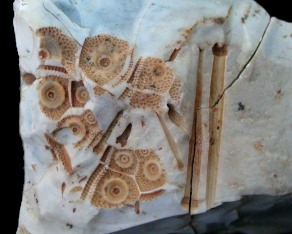 A
A
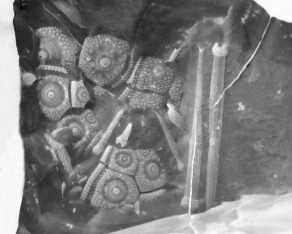 B
B
10). Mould in flint of a crushed test with associated spines. (A) natural-colour image; (B) negative image)(x3, Worthing, gravel float, Randell Collection, RR0193).